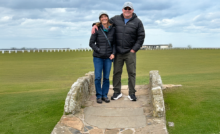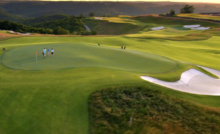Hardscapes on the Golf Course
I have always been interested in landscape design and construction well before I received a Horticulture degree from Oregon State University. While I was in school, I worked at the Corvallis Country Club where I was given an opportunity to design a flower bed on the course. The budget for this master piece was next to nothing, but I was gung ho to make it the coolest thing ever. It ended up being a simple circular bed with a CCC boxwood topiary boarded with rocks and filled in with annuals. It wasn’t that impressive but, it still exists to this day (18 years later). As time passed, I constantly thought about ways to reduce the maintenance of my magnum opus since we did not have the manpower to string trim around the rocks and weed the flower bed (according to my grand vision). A mow strip around the rocks was sprayed with Glyphosate and some weeds weren’t removed until they were the size of the annual flowers themselves (that may be a slight exaggeration). Over the years, this basic inexpensive bed was costing much more to maintain than it ever did to install. We did the best we could but, I couldn’t help thinking about the monster I created for the maintenance staff. As a result, I spent a great deal of time considering post construction maintenance costs of landscape projects. The value of a great landscape will diminish over time if maintenance requirements are not understood and adequately funded.
Maintaining a golf course became my passion and the ability to landscape these wonderful properties is like a hobby to me. I have been blessed to be employed at the Roseburg Country Club for the last 14 years where I have been given the opportunity and responsibility to take on a multitude of landscape projects. I have made some mistakes along the way but always strive to learn from them. Conquering the challenges of each new project and learning a new skill or technique make a golf course superintendent position the most rewarding career anyone could have. I am fortunate to have a dedicated staff and loyal assistant who make our operation a success. Without them and the generous contributions and involvement of our membership, none of this would be possible.
We try not to increase the landscaped areas on the golf course unless it resolves a maintenance issue. First and foremost, this is a golf course and the landscaped areas are an enhancement not a burden. The following hardscape projects use concrete paverstones as the primary construction component. I don’t want to bore you with all the construction detail but, I would like to highlight a few of the significant elements.
The Roseburg Country Club has been changing construction material for steps and walkways from traditional railroad ties to paverstones over the last 14 years. The conversion from metal spikes to soft spikes solved many problems on the greens and the floor surfaces in the pro shop; however a new hazard developed since soft spikes do not track well on railroad ties. The ease of working with pavers and the variety of shapes and sizes open the door for endless creative designs while providing a functional and safe surface to walk on.
Initially we used paverstones to make foundations for memorial benches on the course. Our memorial benches weighed over 100 pounds and moving them on a daily basis was not a viable option. Concentrated traffic around benches required a durable surface to prevent mud puddles in front of the benches. Design and installation of these paverstone pads is very basic and measured to eliminate the need for cutting any bricks.
The success of the bench pads led to utilizing pavers for steps from the cart path to the teeing grounds. Our first set of tee steps were framed in with 4 inch by 6 inch pressure treated wood and the tread was filled in with paverstones. The wood on the sides of the steps is angled following the grade of the slope so mowing equipment could be operated next to the steps eliminating the need for string trimming. At that point in time, some members were still using metal spikes on a limited basis and the wood front provided traction for metal spikes while the brick tread provided traction for soft spikes. The wood on the leading edge of the step was installed in a manner that it could be replaced without taking all the steps apart. “As a rule of thumb, for outdoor steps in regular (architectural) flights- the sum of the heights of two risers plus the depth of the tread will equal 26 inches.”
Riser + Tread + Riser = 26”
4” + 18” + 4” = 26”
5” + 16” + 5” = 26”
6” + 14” + 6” = 26”
(Ormsbee Simonds, 1983)1
In 2005 Roseburg Country Club built a new clubhouse and we were tasked with the design and installation of the landscape. A free form walkway was installed in front of the clubhouse with a seating area backed by a Windsor Stone retaining wall system. To create an ornate design, a soldier course was installed around the perimeter of the path. A brick saw is necessary to make precise cuts and labor for the install is more. To accent the soldier coarse and light the path, low voltage lights (the dimension of a brick) border the path below a Windsor Stone retaining wall. The dim lights create a tranquil ambiance and demarcate the edge of the path.
The latest project in 2010 entailed replacing railroad tie/pea gravel steps with a 10% sloped paverstone path framed in with a soldier course. There was enough room in this situation to eliminate steps all together and build a sloped path eliminating the need for any wood. The path was framed in with snap edging nailed down with 10 inch spikes. The key to finishing any paverstone project is to brush polymer sand in between the bricks, compact with a vibraplate followed by water to activate the polymer. The polymer sand sets up like mortar when dry and it becomes flexible when wet. This significantly reduces weed growth between the bricks thus making the surface look great without having any weed problems down the road. Concrete brick manufactures also recommended sealing the brick every 2 years to prolong the life and appearance of the paverstones.
Initially paverstones may not be the cheapest material to use but in the long run they will outlast most other materials, require less maintenance, and look great. They can also be reused if alterations are made to an area, making them more cost effective than other alternatives.
Oh yes, you are probably wondering about the flower bed at the Corvallis Country Club, and what my solution would be after all these years. If I were to build it today, I would boarder the bed with a type of retaining wall stone and pour a concrete mow strip around it so mowers could mow up to it without the need of a string trimmer or Glyphosate. Instead of planting annuals, I would cover the bed with a geotextile fabric and plant a dense forming ground cover to suppress weed growth and apply a preemergent herbicide 1-2 times per year. As for the topiary…its current existence speaks for itself. The cost of this type of installation is more up front but less expensive in the long run.
We can’t eliminate all the maintenance and expense of a landscape but we can reduce it through the use of quality materials, proper planning, and knowledge of the plants and materials available.
1 Ormsbee Simonds, J. (1983). Landscape Architecture. United States of America: McGraw-Hill, Inc.
Recent Posts
Discover Puerto Rico for Great Golf Trips and After-Round Activities, Amenities
Golfers cannot live by the game alone which is why Puerto Rico provides the perfect…
Q&A with a Multi-talented Golf Course Architect – Part 2: Making the Rounds – Installment 39
This column features recollections of the author’s 37 years as a golf writer. These installments…
With LOKSAND, Bunker Faces & Edges ‘Aren’t Going Anywhere’
LOKSAND Global has announced North American availability of the stabilization product LOKSAND (www.loksand.com), in addition…
One of the Biggest Jobs in Golf
When Rory McIlroy finally slipped into the Green Jacket on Sunday, April 13, 2025, after…
Audubon International Marks Earth Day In Growth Mode
As the world celebrates Earth Day on April 22, Audubon International – the environmentally focused non-profit…
Help keep golf sustainable by bidding in GCSAA’s Rounds 4 Research online auction
In celebration of Earth Day, you can help fund the research that advances golf’s environmental…



